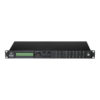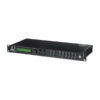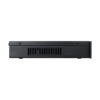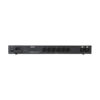Mackie SP260
Out of stock
- Professional 2-input, 6-output system processor for passive and powered PAs
- Sophisticated, intuitive EQ, crossover, delay, and dynamics processing optimizes and protects your system
- High-end 24-bit AKM AD/DA converters with 120 dB dynamic range
- Two balanced XLR inputs with level control, mute, 600 ms delay, and 5-band parametric/shelving EQ
$820.00
Out of stock
The Mackie SP260 2 x 6 Loudspeaker System Processor offers sophisticated EQ, crossover, dynamics processing, and system protection. It provides complete system optimization for both passive and powered systems. Five different operating modes cover a wide range of systems. Each input and output is loaded with a huge range of processing including flexible EQ, crossover, delay, and limiting solutions. It delivers everything you need to professionally optimize loudspeaker systems of nearly any size.
The SP260 utilizes 24-bit AKM AD/DA converters with 120 dB dynamic range for good sound quality. With 24 user-definable presets and flexible I/O for simple routing and configuration, the SP260 is an ultra-flexible processor, suitable for a wide range of portable and permanent applications.
The processor has 2 inputs that instantly connect your mix into a whole host of processing and routing capabilities. Your input signal will never be the same. Each input features a mute switch and variable gain control. Now, you can easily control the whole system regardless of how many boxes you have. You can turn these down and the entire system turns down. It features 5-band EQ on both inputs. You can choose between parametric or high/low shelving, providing a flexible approach to room tuning that is sure to please any professional engineer. There’s even a 600 ms delay available on each input. This is useful when using multiple SP260s to drive delay stacks in really big venues. You can also time align the stage with the main speakers.
There are 6 individual outputs on the Mackie SP260, providing a wide range of possible connections, depending on your system. To start, each output features a mute switch and individual gain adjustment. This allows you to turn up the subs for a bit more low end or get a little more volume to another zone without having to walk out and adjust the power amps.
Each output also features a dedicated 7-band EQ, complete with selectable parametric or shelving control per band. This feature is critical for properly voicing a loudspeaker for the program material being presented or for the venue it is in. Adjusting the voicing with this comprehensive EQ control allows you dial in the suitable response curve for the system and application at hand.
There are many other ways to optimize your passive or active loudspeaker system. The SP260 high and low pass filters allow you to easily create a crossover for your full-range speakers and subs or bi-/tri amped systems. These filters also allow you to roll off frequencies your speaker may not be able to handle. This helps to focus energy where it’s needed, preventing needless heat loss and possible driver over-excursion. There are 8 different types of filters available with varying degree of slope. The following types are available with slope choices in the first through 4th order: Butterworth, Bessel, and Linkwitz-Reilly. For each output, you also get to choose input routing, from input A, input B, or a mono sum of both (suitable for subwoofers or for sending a mono feed to the foyer).
There’s also a 600 ms delay on each output, giving you a wide range of control. You can use it to create delay stacks down the street at a block party. Maybe extra coverage is needed in a balcony for service. You will want to time align that signal for sure. But, if you want to get uber-professional you can take advantage of the fact that the SP260 can adjust delay down to 20 ms increments. This allows you to time-align drivers on stage to provide superior summing. The display conveniently lets you see delay in ms, feet, or meters depending on the situation. You can combine this with the polarity invert feature for a system that is appropriately summed for optimum response.
There’s even a powerful limiter to protect your system from being tampered. A system lock feature keeps your system safe from the occasional (and, of course, accidental) bump. You can even impose a password protection system for enhanced security.
Professional Sound Quality
The SP260 is specifically designed for the professional audio engineer. If you know your Butterworths from your Bessels, or if Linkwitz-Reily is your middle name, the SP260 gives you total control over every single parameter. You can adjust the system based on the venue and gear and be rest assured of achieving premium sound quality. With high-end AKM AD/DA converters with 120 dB dynamic range and a DSP engine and algorithms, you can count on superior sound quality every time.
Simple Setup
You can easily choose from a range of pre-configured system setups to assign the correct inputs; name outputs and provide the starting crossover point for your system. This saves time when dealing with complicated systems that involve zone control, cry rooms, or with bi- or tri-amped loudspeakers. From there, use all the available input and output processing to optimize your system for the venue. Once that’s done, you can easily save the setup in one of the 24 available presets. This is useful when you use your system in the same place often or switch between different sets of gear, depending on the venue. Downloadable presets have been created for popular systems that give you a huge head start for setup. Plus, with the ability to link inputs or any combination of outputs, you can save serious time adjusting parameters that you intend to repeat on other channels.
Powerful Desktop Software
With the SP260 Control Application, you have total control over your system from an easy-to-use interface. Just plug in your Windows laptop via the convenient front panel USB port to harness the power of the app. The software auto-detects the SP260 and shows the current settings. Each and every SP260 feature is controllable using the app, which features a high-contrast design suitable for low-lit areas like the front of the house. The smart design of the app is built around maximum workflow, so all processing elements for any input or output are viewable and controllable from a single screen. You can even manage and store your presets on the PC for later implementation. This allows you to setup for shows ahead of time or adjust things you’d like to improve for the next show.
A Complete System Solution
Passive, powered, bi-amped, tri-amped, delay stacks, fill stacks, cry rooms, and balcony clusters. Everything is manageable with the SP260. Getting total control over your system and sounding professional has never been easier. The SP260 is a potent piece that suits and protects your powered or passive PA.
FEATURES
- Professional 2-input, 6-output system processor for passive and powered PAs
- Sophisticated, intuitive EQ, crossover, delay, and dynamics processing optimizes and protects your system
- High-end 24-bit AKM AD/DA converters with 120 dB dynamic range
- Two balanced XLR inputs with level control, mute, 600 ms delay, and 5-band parametric/shelving EQ
- Six balanced XLR outputs with level control, mute, polarity invert, dedicated high and low pass filters, 7-band parametric/shelving EQ, 600 ms delay, and limiting
- Powerful limiter on every output for ultimate protection
- Convenient front-panel controls for parameter editing and input/output muting
- USB port for simple programming via PC
- Linkable inputs and outputs for easy stereo configuration
- 7-segment LED metering for input/output level or limiter activity
- 5 Operating Modes: 2 x stereo + sub, 3 x stereo, 2 x 2-way + sub, 2 x 3-way, and 1 x 6-way
- 24 presets for storing your Mackie or other system parameters
- Switchmode Power Supply: 100 to 240V
- Compact, single rack unit design
Specifications
| Brands | Mackie |
|---|---|
| Product Type | PA System Processors |
Preset Function
| Operating Modes | 2 x Stereo + Sub: 2 full-range loudspeaker pairs and a pair of (mono by default) subwoofers
2 x 2 Way + Sub: 2 bi-ampable full-range loudspeakers and a pair of (mono by default) subwoofers 2 x 3 Way: 2 tri-ampable full-range loudspeakers 3 x Stereo: 3 full-range loudspeaker pairs 1 x 6 Way: Mono 6-way setup |
Input
| Gain | ±15 dB
±0.1 dB increments |
| Delay | Time (ms): 0.00 to 600.99 ms
±1.00 & ±0.02 ms increments Distance: 0.00 to 670.23′ (0.00 to 204.33 m) ±1.11 & ±0.02′ (±0.34 & ±0.007 m) increments |
| Bypass | EQ: On or Off |
| Band | 5-Band EQ:
Frequency: 20 Hz to 20 kHz, 1/24 octave increments Bandwidth: 0.05 to 3.0, ±0.05 increments Gain: ±15 dB, ±0.05 dB increments High or Low-Shelving: 6 or 12 dB/octave |
Output
| Name | User-editable |
| Source | InA, InB, InA+InB |
| Polarity | 180˚ invert |
| Gain | -12.0 to +6.0 dB, ±0.1 dB increments |
| Bypass | EQ: On or Off |
| Band | 7-Band EQ:
Frequency: 20 Hz to 20 kHz, 1/24 octave increments Bandwidth: 0.05 to 3.0, ±0.05 increments Gain: ±15 dB, ±0.05 dB increments High or Low-Shelving: 6 or 12 dB/octave |
| Delay | Time: 0.00 to 600.99 ms
±1.00 & ±0.02 ms increments Distance: 0.00 to 670.23′ (0.00 to 204.33 m) ±1.11 & ±0.02′ (±0.34 & ±0.007 m) increments |
| Filter | High- and Low-Pass:
Frequency: 20 Hz to 20 kHz Filter / Slope: No Cut-Off Butterworth 6 dB/octave Butterworth 12 dB/octave Linkwitz-Riley 12 dB/octave Bessel 12 dB/octave Butterworth 18 dB/octave Butterworth 24 dB/octave Linkwitz-Riley 24 dB/octave Bessel 24 dB/octave |
| Limiter | Attack: 5 to 200 ms
(5 ms to 20 ms) ±1 ms increments (20 ms to 30 ms) ±5 ms increments (30 ms to 100 ms) ±10 ms increments (100 ms to 200 ms) ±20 ms increments Release: 0.1 to 3.0 sec, ±0.1 sec increments Threshold: -10 to +20 dBu, ±0.2 dBu increments |
Analog Input Level
| Connector | 2 balanced XLRs |
| Max Input Signal | Line Level: +20 dBu |
| CMRR | >58 dB |
| Input Meters | Range: Clip: -20, -10, 0, +3, +9, +15 dBu |
Analog
| Connector | Outputs: 6 balanced XLRs |
| Max Input Signal | Line Level: +21 dBu |
| Meter | Output Range:
Level Mode: Limit Mode Limit: Limit Clip: 0 dBr +15 dBu: -3 dBr +9 dBu: -6 dBr +3 dBu: -9 dBr 0 dBu: -12 dBr -15 dBu: -15 dBr |
A/D – D/A Conversions
| Converter | Type: 24-bit AKM |
| Dynamic Range | 120 dB |
| Sample Rate | 48 kHz |
| Bit Depth | 24-bit |
Noise Characteristics
| Frequency Response | 20 Hz to 20 kHz, ±0.2 dB |
| Dynamic Range | 111 dB A-weighted
108 dB unweighted |
Frequency
| Distortion | Frequency: 20 Hz to 20 kHz: <0.004% |
Input / Output
| Crosstalk | Interchannel: 22 Hz to 22 kHz (unweighted)
-107 dB (+20 dBu @ 1 kHz) Input to Output: -107 dB (+20 dBu @ 1 kHz) |
USB
| Format | USB 1.1 |
Power Requirements
| Power Consumption | AC: 40 W |
| Power Supply (AC) | Universal: 100 to 240 VAC, 50 to 60 Hz |
| Power Connector | 3-pin IEC |
| Operating Temperature | Extended Ambient Temperature: 32 to 104˚F (0 to 40˚C) |
| Software Requirements | PC: Microsoft Windows 7 32/64 SP 1, Vista 32/64 SP 2 or XP 32 SP 3
Pentium 4, Celeron, or Athlon XP processor 512 MB RAM |
Physical Characteristics
| Display | 2 x 24-character LCD with backlight |
| Height | 1.8″ (46.0 mm)
(1U rack mount design) |
| Width | Front: 19.0″ (483.0 mm)
Rear: 17.3″ (439.0 mm) |
| Depth | 9.0″ (229.0 mm) |
| Weight | 5.8 lb (2.6 kg) |
Based on 0 reviews
Only logged in customers who have purchased this product may leave a review.
You may also like…
-
Studio Monitors, Speakers
PreSonus Eris E5XT Studio Monitor (Pair)
- 5.25-inch woven composite low-frequency transducer
- 1-inch (25 mm), ultra-low-mass, silk-dome, high-frequency transducer
- Front-firing acoustic port for superior bass-frequency reproduction
- Optimized, resonance-suppressing internal bracing
SKU: n/a -
Production & Groove, Studio & Recording
PreSonus FaderPort Production Controller
- Single touch-sensitive, 100 mm long-throw, motorized fader
- Large, 360° button encoder
- Complete recording-transport controls: Play, Stop, Fast Forward, Rewind, Record, Loop
- Drop Marker, Next/Prev Marker, Next/Prev Event
SKU: n/a






















There are no reviews yet.